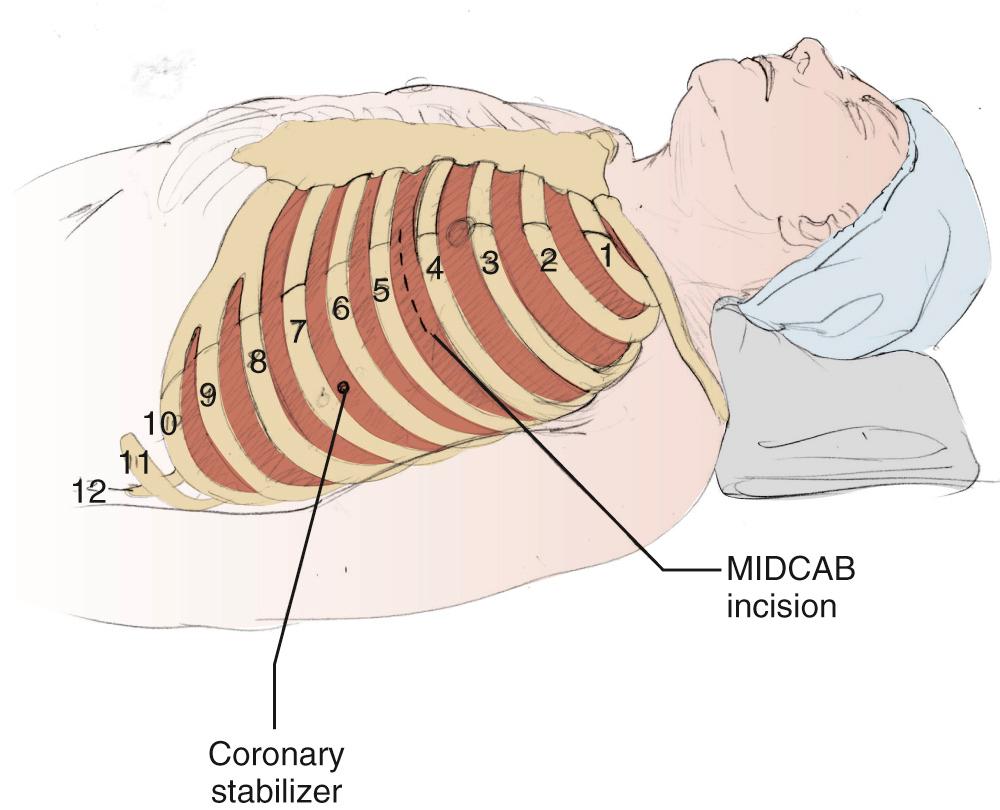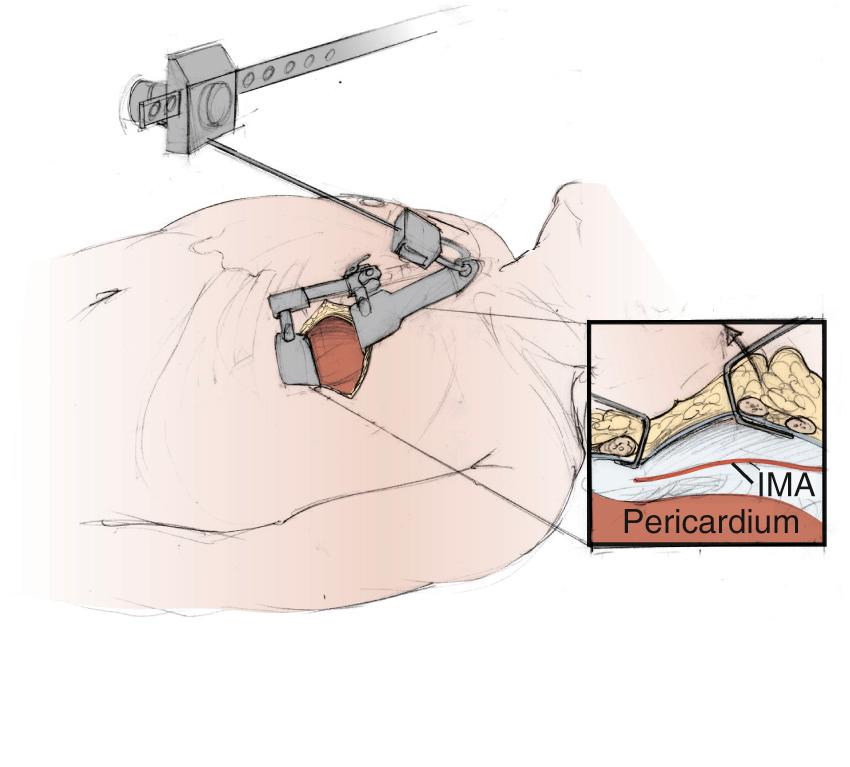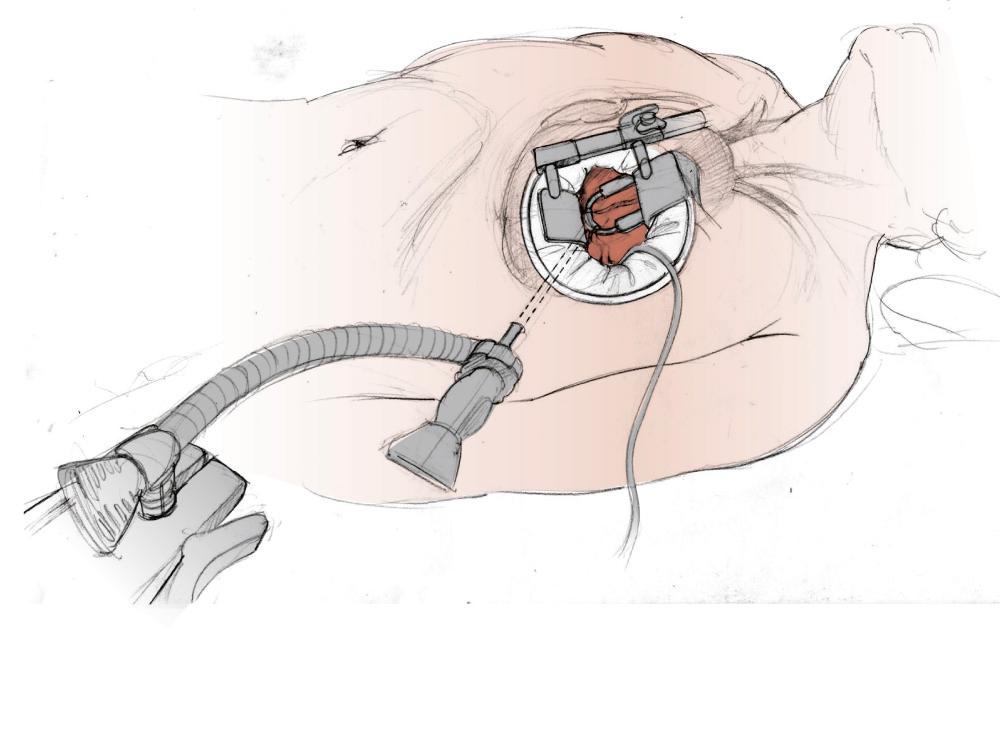Physical Address
304 North Cardinal St.
Dorchester Center, MA 02124
The standard approach for coronary artery bypass grafting (CABG) is median sternotomy using cardiopulmonary bypass. However, less invasive approaches, including off-pump CABG and smaller access surgeries with or without robotic assistance, have been developed. This chapter describes less invasive methods of coronary revascularization along with their associated outcomes, with emphasis on robotic CABG. Hybrid coronary revascularization techniques are also considered.
Many alternatives to surgical coronary revascularization have been developed in the form of modifications to conventional CABG. These alternatives come under the broad rubric minimally invasive coronary revascularization.
It should be noted that when used in the realm of cardiac surgery, this description “minimally invasive” carries more possible meanings than in other surgical specialties. In contrast to other surgical disciplines where the degree of invasiveness of a procedure is primarily defined by the size of access incisions, in cardiac surgery at least two forms of invasion can be altered. The trauma of physical access can be changed by the use of smaller incisions that involve less (or no) sternal splitting. The physiologic invasiveness can be altered by performing procedures off pump, that is, without the use of cardiopulmonary bypass and cardioplegic arrest. This at least theoretically modifies the degree of physiologic perturbation produced in performing the intervention.
The face of surgical coronary revascularization has been changed by innovations in both of these areas and inventions like the octopus stabilizer, spreaders for mini-thoracotomy approaches, devices for local coronary artery occlusion and shunting, the CO 2 mister-blower, long-shafted thoracoscopic instrumentation, robotic devices, and minimally invasive extracorporeal circulation have led to a completely different appearance of coronary surgery. Because off-pump coronary artery bypass (OPCAB) grafting is covered in Chapter 89 , it will not be covered in depth here; rather, this chapter describes techniques of surgical revascularization using access incisions other than conventional median sternotomy, with or without the use of cardiopulmonary bypass. The degree of revascularization possible with each intervention is discussed as well as some of the literature on the clinical outcomes associated with these approaches, with emphasis on robotically assisted approaches.
A minimally invasive direct coronary bypass (MIDCAB) operation (also referred to as single-vessel small thoracotomy direct-vision bypass grafting [SVST]) is a procedure using an anterior, medially placed, mini-thoracotomy incision. The incision is used for both direct-vision left internal mammary artery (LIMA) harvest and creation of an anastomosis of the LIMA to a coronary artery. It is performed off pump and requires the use of a stabilizer placed either directly through the operative incision or through a separate port incision.
Because of the limited access to the lateral and posterior surfaces of the beating heart during this procedure, coronary revascularization using MIDCAB is generally limited to the bypass of the left anterior descending (LAD) artery or its diagonal branches. To allow for takedown of the internal mammary artery (IMA) through this incision, specially designed retractors are available. (In the early development of MIDCAB, rib disarticulation or removal of cartilage was carried out.) The MIDCAB, therefore, essentially amounts to a one-vessel OPCAB to the LAD or its diagonal branches through a small thoracotomy.
Having originally been described in 1965 by Kolessov, the MIDCAB procedure was reintroduced in the mid-1990s. The procedure was adopted at many U.S. and European centers after its reintroduction, and many early series demonstrated decreased hospital lengths of stay relative to conventional CABG, decreased utilization of resources, earlier return to full activity, reduced transfusion requirement, and excellent graft patency. When compared to a single-vessel OPCAB, data are limited; however, small studies suggested that durations of mechanical ventilation and total hospital stay were decreased with use of MIDCAB.
The main downside of this procedure is challenging early postoperative control of pain caused by the chest wall retraction involved in LIMA harvest. Even with the smaller incision, the difficulties with postoperative pain may have contributed to the decrease in popularity of this procedure after its original introduction. Nevertheless, several centers skilled in this approach continue to perform it in large numbers and report excellent results.
For example, in one recent European report, Holzhey and coworkers reported their experience with 1768 MIDCABs between 1996 and 2009. This Leipzig group reported a 1.75% rate of conversion to sternotomy, 0.8% postoperative mortality rate, and 0.4% perioperative stroke rate. Routine postoperative angiograms showed 95.5% early graft patency, with a short-term target vessel reintervention rate of 3.3%. MIDCAB procedures have also been used successfully in the reoperative arena with some evidence of decreased operative mortality. The general acceptance of MIDCAB is low, and despite initial enthusiasm, several centers have abandoned the procedure. The significant learning curve for an individual surgeon to reach stable results (additionally requiring continuously high case loads to sustain surgeon skill ) and less than optimal graft patency at some centers are probably the main causes for this phenomenon.
All patients should undergo the complete preoperative workup that is standard for open CABG. The patient's body mass index and body habitus are of worthy of note; obesity is a relative contraindication for MIDCAB because the pressure placed on the wound edges by the retractor during LIMA takedown may cause tissue necrosis and predispose the patient to wound infection. For similar reasons, female patients with large breasts may be at increased risk for wound-related complications. With regard to preoperative imaging, preoperative assessment of heart position relative to the interspaces on chest x-ray may be helpful in the planning of the access incision.
The patient is positioned supine with the left side up. Optimally single-lung ventilation is used; however, this is not absolutely necessary. If single-lung ventilation is not used, reduction in tidal volume and packing of the lung away from the field can be used. A left submammary incision in the mid-clavicular line in either the fourth or fifth interspace is used ( Fig. 90-1 ). Review of the heart position relative to the interspaces on preoperative chest x-ray can be helpful in the planning of the access incision. It should be noted that the incision is the lower limit of LIMA takedown; the chest wall caudal to the incision cannot be visualized. Therefore, some physicians preferentially take the fourth interspace approach to obtain maximal conduit length. This consideration is important in the case of a distal LAD lesion. Some reports have described extensions of the LIMA by a segment of an additional arterial conduit to reach distal LAD targets and to avoid graft tensions.

Following incision, a chest wall retractor is inserted for LIMA takedown. In general, retractors used for this purpose (e.g., those made by Medtronic, Inc., Minneapolis, MN) have an elongated superior blade designed to retract the upper ribs away, preventing their acting as a shelf limiting visualization ( Fig. 90-2 ). The pleural fat is dissected away, the endothoracic fascia is exposed and incised with bovie electrocautery, and the LIMA is taken down in skeletonized fashion. It is recommended to locate the LIMA medial to the incision and proceed cephalad to the level of the subclavian vein. After heparin reaches activated clotting time (ACT) levels of 300 sec, the artery is divided at its distal extreme and the LIMA retractor is replaced with a standard thoracotomy retractor.

The pericardial fat pad is then removed. The phrenic nerve should be identified and the pericardium incised longitudinally anterior to it to the level of the base of the heart. The apex is identified and the LAD in its position to the right of the apex coursing parallel to the sternum. Care must be taken not to misidentify the diagonal artery as the LAD, which may be the first artery visualized. In contrast to the LAD, the diagonal artery courses parallel to the incision and toward the apex. Pericardial stay sutures may be useful in positioning the heart.
Once the LAD has been identified, it is stabilized either directly via the incision or using an endostabilizer brought through a separate lateral stab incision ( Fig. 90-3 ). If the latter is used, this incision can also be used later for chest tube placement. Silastic loops are placed proximally and distally if necessary (note that distal snares should be avoided because they can lead to scar lesions and impaired flow), and the artery is exposed. Premedication with lidocaine or other antiarrhythmic can be used before vessel occlusion. Should hemodynamic compromise be encountered following occlusion, a 1.5-mm intracoronary shunt can be used, with the vessel occluders released, while the anastomosis is created. Whether shunted or not, anastomosis creation is performed in the standard fashion with 7-0 Prolene. It is recommended to assess flow with transit time ultrasound.

After heparin reversal and confirmation of hemostasis, the pericardium is loosely reapproximated to prevent heart herniation and adherence of the apex to the intercostal space. Some authors recommend reapproximation using a patch of bovine pericardium for this purpose. It is important to take care to avoid kinking of the LIMA, particularly as it passes through the pericardium during this process. A nerve block may be achieved by direct infiltration of 0.5% bupivacaine into the posterior intercostal spaces from ribs four to six. A single chest tube is placed in the left chest, the ribs are reapproximated, the pectoral muscle is reapproximated, and the skin is closed in standard fashion.
Patients can be extubated on the table; however, if patients are left intubated, any double-lumen endotracheal tubes inserted should be exchanged for single-lumen tubes. Aggressive pain management and a strategy of early mobilization should be instituted. If necessary, a thoracic epidural catheter may be used if less invasive pain control methods (narcotics, Lidoderm topical patches, etc.) are not sufficient. No sternal precautions are required following MIDCAB.
It is recommended to begin aspirin and clopidogrel 6 hours after surgery or once chest tube drainage is minimal ; there is some evidence that the use of dual antiplatelet therapy reduces the risk of perioperative myocardial infarction and graft occlusion in off-pump revascularization procedures.
In an effort to avoid the degree of chest retraction typically involved in the standard MIDCAB procedure, other approaches to LIMA takedown have been developed. In the video-assisted MIDCAB approach (also referred to as “endo-ACAB”), the LIMA is harvested thoracoscopically via small access port incisions. The LIMA-LAD anastomosis is created through a mini-thoracotomy with minimal rib spreading. It should be noted that thoracoscopic LIMA takedown requires chest cavity insufflation, and patients' ability to tolerate diminished ventilation intraoperatively should be assessed preoperatively.
The largest series of thoracoscopic MIDCAB was reported by Vassiliades and colleagues in 2007 who termed this approach endoscopic atraumatic coronary artery bypass (endo-ACAB). This group reports a 3.6% conversion to sternotomy or thoracotomy rate, a 1% postoperative mortality rate (to be compared to the STS National Database–predicted 30-day mortality of 2.7%), and a 0.3% stroke rate. These authors report a 96% LIMA-LAD patency rate with a mean follow-up of 18 months. The mean length of stay in the intensive care unit was 11.2 ± 9.9 hours, and in the hospital, 2.4 ± 1.3 days.
Likely because of the advanced thoracoscopic skills necessary for the LIMA takedown in this approach (with an estimated 50-case learning curve required for mastery of the technique ), the thoracoscopic MIDCAB has not achieved widespread adoption at this time. However, centers with expertise in the technique have obtained promising results. Robotically assisted MIDCAB represents an alternative to thoracoscopic MIDCAB and is discussed in conjunction with other robotic revascularization techniques later.
All patients should undergo the complete preoperative workup that is standard for open CABG. The patient's body mass index and body habitus are worthy of note, as in open MIDCAB. In general, patients with body mass index less than 30 are the most straightforward for those surgeons early in their learning curve. Women with large breasts can be challenging because port sites may need to pass through the breast itself, or a larger submammary incision may be required. Preoperative spirometry may be helpful in determining the patient's ability to tolerate the single-lung ventilation (with forced expiratory volume in 1 second [FEV 1 ] < 1 usually representing the cutoff value).
As in an open MIDCAB, the patient is positioned supine on the operating room table with the left side up.
Under single-lung ventilation, three ports are placed in the left midaxillary line in the third, fifth, and seventh interspaces (some physicians recommend the fifth interspace port be placed in the anterior axillary line ). Standard thoracoscopic instruments can be used. A 30-degree (either 5-mm or 10-mm) thoracoscope is inserted via the fifth space first, and carbon dioxide insufflation is initiated to a target pressure of 8 mm Hg to increase the workspace inside the chest. It should be noted that if hemodynamic compromise is observed (a result of hypertensive pneumothorax, especially in patients with compromised left ventricular function) at this stage, it may be necessary to decrease the rate of insufflation or to evacuate some of the carbon dioxide from the thoracic space. The endoscope should then be inserted and a general view of the intrathoracic space obtained.
Next, a grasper and electrocautery or harmonic scalpel are inserted through the third and seventh interspaces. Following dissection of pleural fat, the endothoracic fascia is visualized. The fascia should be incised approximately 1 cm lateral to the IMA and retracted downward. Using gentle spatulation with the electrocautery or harmonic scalpel to identify the side branches of the IMA, the entire IMA can be harvested from the subclavian vein to the level of the xiphoid process through the cautery or harmonic division of its branches (clips are seldom used) in pedicled fashion. Care should be taken at the level of the first rib to avoid damage to the phrenic nerve and subclavian vein.
The pericardium may be opened and the target vessel identified. Anastomosis creation proceeds in a manner similar to that described for open MIDCAB, with incision placement guided by the thoracoscope. One of the port sites may be used for endostabilizer placement and subsequently the chest tube.
As in open MIDCAB, patients may be extubated on the table; however, if patients are left intubated, double-lumen endotracheal tubes should be exchanged for single-lumen tubes. Aggressive pain management and a strategy of early mobilization should be instituted. No sternal precautions are necessary. It is recommended to begin aspirin and clopidogrel 6 hours after surgery or once chest tube drainage is in keeping with the evidence that the use of dual antiplatelet therapy reduces the risk of perioperative myocardial infarction and graft occlusion in off-pump revascularization procedures.
Become a Clinical Tree membership for Full access and enjoy Unlimited articles
If you are a member. Log in here